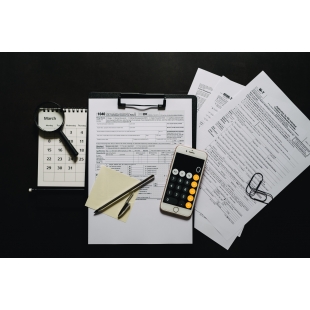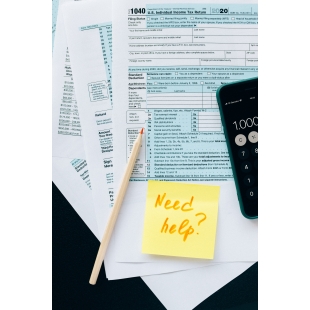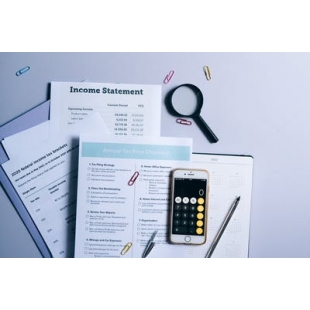All News
-

Sino-American CPAs Association visited the Taipei CPA Association — Joy Yang, an American accountant, was invited to attend the full-day agenda
Sino-American CPAs Association visited the Taipei CPA Association — Joy Yang, an American accountant, was invited to attend the full-day agendamore -

Grandparents and others with eligible dependents shouldn’t miss out on the 2021 child tax credit
COVID Tax Tip 2022-165, October 27, 2022
Grandparents, foster parents or people caring for siblings or other relatives should check their eligibility to receive the 2021 child tax credit. People who claim at least one child as their dependent may not realize they could be eligible to benefit from the child tax credit.
Eligible taxpayers who received advance child tax credit payments last year should file a 2021 tax return to receive the second half of the credit. Eligible taxpayers who did not receive advance child tax credit payments last year can claim the full credit by filing a 2021 tax return.
People should review the eligibility rules to make sure they still qualify for the credit. The Interactive Tax Assistant can help people who aren't sure. Taxpayers who haven't qualified in the past should also check because they may now be able to claim the credit. The only way to receive the credit is to file a 2021 federal tax return.
What is the child tax credit expansion?
The child tax credit expansion increased the amount of money families can receive per child and expanded who can receive the payments. The credit increased from $2,000 to $3,600 per child for children under the age of six, from $2,000 to $3,000 for children over the age of 6 and raised the age limit from 16 to 17 years old.
The child tax credit expansion applies to tax year 2021 only.
Who qualifies for the child tax credit?
Taxpayers can claim the credit for each qualifying child who has a Social Security number that is valid for employment in the United States and issued by the Social Security Administration before the due date of their tax return. This includes the filing extension if the taxpayer requested the extension by the tax return's original due date.
To be a qualifying child for the 2021 tax year, the child must fit certain criteria.
What are the eligibility factors?
Individuals qualify for the full amount of the 2021 child tax credit for each qualifying child if they meet all eligibility factors and their annual income is not more than:
$150,000 if they're married and filing a joint return, or if they're filing as a qualifying widow or widower.
$112,500 if they're filing as a head of household.
$75,000 if they're a single filer or are married and filing a separate return.
Parents and guardians with higher incomes may be eligible to claim a partial credit.
IRS Free File available until November 17 to help more people receive credits
The IRS Free File program offers eligible taxpayers brand-name tax preparation software to use at no cost. It's free for most individual filers who earned $73,000 or less in 2021. To help more people claim a variety of tax credits and benefits, Free File will remain open for an extra month this year, until November 17, 2022.
Taxpayers who earned more than $73,000 in 2021 and are comfortable preparing their own taxes can use Free File Fillable Forms. This electronic version of paper IRS tax forms is also used to file tax returns online.
More information:
2021 Child Tax Credit and Advance Child Tax Credit Payments Frequently Asked Questions
Subscribe to IRS Tax Tips
Source: https://www.irs.gov/newsroom/grandparents-and-others-with-eligible-dependents-shouldnt-miss-out-on-the-2021-child-tax-credit
US TAX, U.S. TAXGrandparents and others with eligible dependents shouldn’t miss out on the 2021 child tax creditmore -

Important info for people considering making early withdraws from retirement funds
COVID Tax Tip 2022-162, October 24, 2022
No matter how much people plan, unexpected events occur. Often, those events result in unplanned expenses. To cover these costs sometimes people, withdraw funds from their retirement savings early. While this may seem like an easy way to get cash quick, early withdrawals can come with heavy penalties and costly tax consequences. Here's some important info for people to consider before they dip into their hard-earned retirement savings.
Workplace retirement plans: 401(k), 403(b) and 457(b)
These plans can distribute benefits only when certain events occur. The plan's summary description should clearly state when a distribution can occur. It will also state if the plan allows hardship distributions, early withdrawals or loans.
Hardship distributions are withdrawals from a participant's account made because of an immediate and heavy financial need and it's limited to the amount necessary to satisfy that financial need. The need of the employee includes the need of the employee's spouse or dependent.
Hardship distributions are includible in gross income unless they consist of designated Roth contributions.
Distributions before the participant turns 65, or the plan's normal retirement age, if earlier, may result in an additional income tax of 10% of the amount withdrawn.
Repaying hardship distributions back to the plan or rolling it over to another plan or IRA isn't permitted.
Borrowers repay loans from these plans back to the retirement account. Borrowers should review the limits on loan amounts and other requirements. Taxes on this money don't occur if the loan meets the rules and repayment happens on schedule.
Required minimum distributions
Taxpayers must make required minimum distributions each year beginning with the year the taxpayer turns 72, 70 ½ if the taxpayer turned 70 ½ in 2019. People calculate the RMD by dividing the IRA account balance as of December 31 of the prior year by the applicable distribution period or life expectancy. RMDs are waived for 2020 due to COVID-19 relief provisions. Required minimum distributions are not required for Roth IRA.
IRAs and IRA-based plans
Individuals can take distributions from their IRA, SEP-IRA or SIMPLE-IRA at any time. Taxpayers do not need to show a hardship to take a distribution – they can just contact the financial institution managing the account.
Early distributions occur when individuals withdraw money from an Individual Retirement Account or retirement plan before age 59½.These retirement plan distributions are subject to income tax. Individuals must also pay an additional 10% early withdrawal tax unless an exception to the early distribution tax applies.
Regardless of age, the account holder must file a Form 1040 Individual Income Tax Return showing the amount of the withdrawal and complete and attach a Form 5329, Additional Taxes on Qualified Plans, Including IRAs, and Other Tax-Favored Accounts, to the tax return. These are requirements for early withdrawals and regular distributions.
Coronavirus-related distributions and loans
The CARES Act made it easier to access savings in IRAs and workplace retirement plans for those affected by the coronavirus. Certain distributions made from January 1, 2020, through December 30, 2020, from IRAs or workplace retirement plans to qualified individuals may be treated as coronavirus-related distributions.
These distributions aren't subject to the 10% additional tax on early distributions, including the 25% additional tax on certain SIMPLE IRA distributions.
Repayment to an IRA or workplace retirement plan can occur within three years.
Taxpayers can include Coronavirus-related distributions in income over 3 years, one-third each year, or if elected, in the year of the distribution.
Divorce-related distributions
Early distributions taken from a traditional IRA to satisfy a divorce requirements or court order are subject to regular income tax requirements and the 10% additional tax unless there is a qualifying exception.
Source: https://www.irs.gov/newsroom/important-info-for-people-considering-making-early-withdraws-from-retirement-funds
US TAX, U.S. TAXImportant info for people considering making early withdraws from retirement fundsmore -

Topics in the News
Here you'll find items of current interest — new programs, recent guidance or timely reminders.
Tax extension filers don't need to wait until October 17
Taxpayers who requested an extension to file their 2021 tax return don't have to wait until mid-October to file. If a taxpayer has all the necessary information to file an accurate return, they can file electronically at any time before the October deadline and avoid a last-minute rush to file.
Taxpayers who requested more time to file an accurate return have until October 17, 2022. Those who have what they need to file, however, should file as soon as possible to avoid delays in processing their return.
Tax season alerts and planning ahead for 2023
Taxpayers face a number of issues due to critical tax law changes that took place in 2021 and ongoing challenges related to the pandemic. The IRS continues to share updated information for people now filing their 2021 tax returns and those planning for the 2022 return they will file next year, as well as anyone who has previous year tax returns awaiting processing by the IRS.
This special alerts page is designed to help anyone whether they are now preparing their tax return or are awaiting processing of a return or refund and the latest updates on IRS letters, or notices. Newer updates will be placed at the top of this page; the IRS will also provide critical updates through social media.
Coronavirus Tax Relief
For the latest information about coronavirus tax relief, see the Coronavirus Tax Relief and Economic Impact Payments page.
Visit our Coronavirus and Economic Impact Payments: Resources and Guidance page for our latest content including news releases, Tax Tips, frequently asked questions, multilingual partner materials and more.
To learn about IRS operations during COVID-19, visit our operations page for up-to-date status on affected IRS operations and services.
Outreach Connection
Get free tax content to share with your staff, clients, customers or colleagues that you can include in your:
Website
e-Newsletter
Twitter, Instagram or other social media
Taxpayer Bill of Rights
All taxpayers have a set of fundamental rights they should be aware of when dealing with the IRS. Explore your rights and our obligations to protect them.
The Right to Be Informed
The Right to Quality Service
The Right to Pay No More than the Correct Amount of Tax
The Right to Challenge the IRS's Position and Be Heard
The Right to Appeal an IRS Decision in an Independent Forum
The Right to Finality
The Right to Privacy
The Right to Confidentiality
The Right to Retain Representation
The Right to a Fair and Just Tax System
Tax Withholding
The IRS encourages taxpayers to perform a quick "paycheck checkup" by using the Withholding Estimator to check if they have the right amount of withholding for their personal situation.
Consumer Alerts on Tax Scams
Note that the IRS will never:
Call to demand immediate payment using a specific payment method such as a prepaid debit card, gift card or wire transfer. Generally, the IRS will first mail you a bill if you owe any taxes.
Threaten to immediately bring in local police or other law-enforcement groups to have you arrested for not paying.
Demand that you pay taxes without giving you the opportunity to question or appeal the amount they say you owe.
Ask for credit or debit card numbers over the phone.
For more information on tax scams, please see Tax Scams/Consumer Alerts. For more information on phishing scams, please see Suspicious emails and Identity Theft.
Source: https://www.irs.gov/newsroom/whats-hot
US TAX, U.S. TAXTopics in the Newsmore -

IRS Updates Public Key for FATCA Filing
IRS Updates Public Key for FATCA Filing
As you are aware, the public/private key pairs used for encryption for FATCA filings have an expiration date.The IRS Public Key for FATCA filing will expire soon. The IRS has a new key and will replace the existing key on Friday, October 14, 2022. After Friday, October 14, you will need to download the new IRS Public Key from IDES ( International Data Excahnge Service) to file your FATCA Reports.
As a reminder,
when purchasing a new digital certificate or replacing one that is about to expire,
->IDES only recognizes and accepts digital certificates issued by IRS approved Certificate Authorities (CA).
For more information on federal taxes please visit IRS.gov.
Source: https://content.govdelivery.com/accounts/USIRS/bulletins/32f7397
US TAX, U.S. TAXIRS Updates Public Key for FATCA Filingmore -
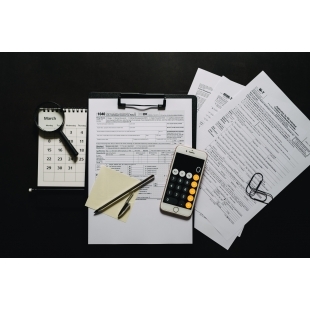
Reminder: File 2019 and 2020 returns by Sept. 30 to get COVID penalty relief
IR-2022-163, September 22, 2022
WASHINGTON ̶ The Internal Revenue Service today reminded struggling individuals and businesses, affected by the COVID-19 pandemic, that
→they may qualify for late-filing penalty relief
if they file their 2019 and 2020 returns by Sept. 30, 2022.
Besides providing relief to both individuals and businesses impacted by the pandemic, this step is designed to allow the IRS to focus its resources on processing backlogged tax returns and taxpayer correspondence to help return to normal operations for the 2023 filing season.
“We thought carefully about the type of penalties, the period covered and the duration before granting this penalty relief. We understand the concerns being raised by the tax community and others about the Sept. 30 penalty relief deadline,” said IRS Commissioner Chuck Rettig. “Given planning for the upcoming tax season and ongoing work on the inventory of tax returns filed earlier this year, this penalty relief deadline of Sept. 30 strikes a balance. It is critical to us to
not only provide important relief to those affected by the pandemic,
but this deadline also allows adequate time to prepare our systems and our workstreams to serve taxpayers and the tax community during the 2023 filing season.”
The relief, announced last month, applies to the failure-to-file penalty. The penalty is typically assessed at a rate of 5% per month, up to 25% of the unpaid tax, when a federal income tax return is filed late. This relief applies to forms in both the Form 1040 and 1120 series, as well as others listed in Notice 2022-36, posted on IRS.gov.
For anyone who has gotten behind on their taxes during the pandemic, this is a great opportunity to get caught up. To qualify for relief, any eligible income tax return must be filed on or before Sept. 30, 2022.
Those who file during the first few months after the Sept. 30 cutoff will still qualify for partial penalty relief. That’s because,
for eligible returns filed after that date, the penalty starts accruing on Oct. 1, 2022, rather than the return’s original due date.
Because the penalty accrues, based on each month or part of a month that a return is late,
filing sooner will limit any charges that apply.
Unlike the failure-to-file penalty, the failure-to-pay penalty and interest will still apply to unpaid tax, based on the return’s original due date. The failure-to-pay penalty is normally 0.5% (one-half-of-one percent) per month. The interest rate is currently 5% per year, compounded daily, but that rate is due to rise to 6% on Oct. 1, 2022.
Taxpayers can limit these charges by paying promptly. For more information, including details on fast and convenient electronic payment options, visit IRS.gov/Payments. Penalty and interest charges generally don’t apply to refunds.
The notice also provides details on relief for filers of certain international information returns when a penalty is assessed at the time of filing. No relief is available for applicable international information returns when the penalty is part of an examination. To qualify for this relief, any eligible tax return must be filed on or before Sept. 30, 2022.
Penalty relief is automatic. This means that eligible taxpayers who have already filed their return do not need to apply for it, and those filing now do not need to attach a statement or other documents to their return. Generally, those who have already paid the penalty are getting refunds, most by the end of September.
Penalty relief is not available in some situations, such as
where a fraudulent return was filed,
where the penalties are part of an accepted offer in compromise or a closing agreement,
or where the penalties were finally determined by a court.
This relief is limited to the penalties that the notice specifically states are eligible for relief. For ineligible penalties, such as the failure-to-pay penalty, taxpayers may use existing penalty relief procedures, such as applying for relief under the reasonable cause criteria or the First-Time Abate program. Visit IRS.gov/penaltyrelief for details.
This relief doesn’t apply to 2021 returns. Whether or not they have a tax-filing extension, the IRS urges everyone to file their 2021 return soon to avoid processing delays. For filing tips, visit IRS.gov.
Source: https://www.irs.gov/newsroom/reminder-file-2019-and-2020-returns-by-sept-30-to-get-covid-penalty-relief
US TAX, U.S. TAXReminder: File 2019 and 2020 returns by Sept. 30 to get COVID penalty reliefmore -

Parents can boost their back-to-school budget by claiming tax credits and refunds
COVID Tax Tip 2022-134, August 31, 2022
Summer is slipping away and another school year is starting. As kids head back to the classroom, parents are ticking items off the school supply list. If they want to boost their back-to-school budgets, parents and guardians should make sure they aren't missing out on their 2021 refunds and tax credits.
Many people don't get their tax refund because they didn't file a federal tax return. Some people choose not to file a tax return because they didn't earn enough money to be required to file. Generally, they won't receive a failure to file penalty if they are owed a refund – but they won't receive their refund either.
A refund isn't the only money people might be missing out on when they don't file. If they're eligible for tax credits, like the child tax credit and the earned income tax credit, they're leaving that money on the table as well.
The child tax credit
The child tax credit helps families with qualifying children get a tax break. People may be able to claim the credit even if they don't normally file a tax return.
Taxpayers qualify for the full amount of the 2021 child tax credit for each qualifying child if they meet all eligibility factors and their annual income isn't more than:
$150,000 if they're married and filing a joint return, or if they're filing as a qualifying widow or widower.
$112,500 if they're filing as a head of household.
$75,000 if they're a single filer or are married and filing a separate return.
Parents and guardians with higher incomes may be eligible to claim a partial credit. The Interactive Tax Assistant can help people check if they qualify.
The earned income tax credit
The earned income tax credit helps low- to moderate-income workers and families get a tax break. If someone qualifies, they can use the credit to reduce the taxes they owe – and maybe increase their refund.
Low- to moderate-income workers with qualifying children may be eligible to claim the earned income tax credit if certain qualifying rules apply to them. People may qualify for the EITC even if they can't claim children on their tax return. Visit IRS.gov to learn how to claim the EITC without a qualifying child.
People who qualify for the EITC, may also qualify for other tax credits, including:
Child tax credit and the credit for other dependents
Child and dependent care credit
Education credits
Recovery rebate credit
More information:
Don't Lose Your Refund by Not Filing
Earned Income Tax Credit
Child Tax Credit
Source: https://www.irs.gov/newsroom/parents-can-boost-their-back-to-school-budget-by-claiming-tax-credits-and-refunds
US TAX, U.S. TAXParents can boost their back-to-school budget by claiming tax credits and refundsmore -

Info to help with tax authorizations now available in traditional Chinese
IR-2022-155, August 24, 2022
WASHINGTON — To help struggling taxpayers affected by the COVID-19 pandemic, the Internal Revenue Service today issued Notice 2022-36PDF, which provides penalty relief to most people and businesses who file certain 2019 or 2020 returns late.
The IRS is also taking an additional step to help those who paid these penalties already. Nearly 1.6 million taxpayers will automatically receive more than $1.2 billion in refunds or credits. Many of these payments will be completed by the end of September.
Besides providing relief to both individuals and businesses impacted by the pandemic, this step is designed to allow the IRS to focus its resources on processing backlogged tax returns and taxpayer correspondence to help return to normal operations for the 2023 filing season.
"Throughout the pandemic, the IRS has worked hard to support the nation and provide relief to people in many different ways," said IRS Commissioner Chuck Rettig. "The penalty relief issued today is yet another way the agency is supporting people during this unprecedented time. This penalty relief will be automatic for people or businesses who qualify; there's no need to call."
The relief applies to the failure to file penalty. The penalty is typically assessed at a rate of 5% per month and up to 25% of the unpaid tax when a federal income tax return is filed late. This relief applies to forms in both the Form 1040 and 1120 series, as well as others listed in Notice 2022-36PDF, posted today on IRS.gov.
To qualify for this relief, any eligible income tax return must be filed on or before September 30, 2022.
In addition, the IRS is providing penalty relief to banks, employers and other businesses required to file various information returns, such as those in the 1099 series. To qualify for relief, the notice states that eligible 2019 returns must have been filed by August 1, 2020, and eligible 2020 returns must have been filed by August 1, 2021.
Because both of these deadlines fell on a weekend, a 2019 return will still be considered timely for purposes of relief provided under the notice if it was filed by August 3, 2020, and a 2020 return will be considered timely for purposes of relief provided under the notice if it was filed by August 2, 2021. The notice provides details on the information returns that are eligible for relief.
The notice also provides details on relief for filers of various international information returns, such as those reporting transactions with foreign trusts, receipt of foreign gifts, and ownership interests in foreign corporations. To qualify for this relief, any eligible tax return must be filed on or before September 30, 2022.
Relief is automatic; most of $1.2 billion in refunds delivered to eligible taxpayers by next month
Penalty relief is automatic. This means that eligible taxpayers need not apply for it. If already assessed, penalties will be abated. If already paid, the taxpayer will receive a credit or refund.
As a result, nearly 1.6 million taxpayers who already paid the penalty are receiving refunds totaling more than $1.2 billion. Most eligible taxpayers will receive their refunds by the end of September.
Penalty relief is not available in some situations, such as where a fraudulent return was filed, where the penalties are part of an accepted offer in compromise or a closing agreement, or where the penalties were finally determined by a court. For details, see Notice 2022-36PDF, available on IRS.gov.
This relief is limited to the penalties that the notice specifically states are eligible for relief. Other penalties, such as the failure to pay penalty, are not eligible. But for these ineligible penalties, taxpayers may use existing penalty relief procedures, such as applying for relief under the reasonable cause criteria or the First Time Abate program. Visit IRS.gov/penaltyrelief for details.
"Penalty relief is a complex issue for the IRS to administer," Rettig said. "We've been working on this initiative for months following concerns we've heard from taxpayers, the tax community and others, including Congress. This is another major step to help taxpayers, and we encourage those affected by this to review the guidelines."
Source: https://www.irs.gov/newsroom/covid-tax-relief-irs-provides-broad-based-penalty-relief-for-certain-2019-and-2020-returns-due-to-the-pandemic-1-point-2-billion-in-penalties-being-refunded-to-1-point-6-million-taxpayers
US TAX, U.S. TAXInfo to help with tax authorizations now available in traditional Chinesemore -

COVID tax relief: IRS provides broad-based penalty relief for certain 2019 and 2020 returns due to the pandemic; $1.2 billion in penalties being refunded to 1.6 million taxpayers
IR-2022-155, August 24, 2022
WASHINGTON — To help struggling taxpayers affected by the COVID-19 pandemic, the Internal Revenue Service today issued Notice 2022-36PDF, which provides penalty relief to most people and businesses who file certain 2019 or 2020 returns late.
The IRS is also taking an additional step to help those who paid these penalties already. Nearly 1.6 million taxpayers will automatically receive more than $1.2 billion in refunds or credits. Many of these payments will be completed by the end of September.
Besides providing relief to both individuals and businesses impacted by the pandemic, this step is designed to allow the IRS to focus its resources on processing backlogged tax returns and taxpayer correspondence to help return to normal operations for the 2023 filing season.
"Throughout the pandemic, the IRS has worked hard to support the nation and provide relief to people in many different ways," said IRS Commissioner Chuck Rettig. "The penalty relief issued today is yet another way the agency is supporting people during this unprecedented time. This penalty relief will be automatic for people or businesses who qualify; there's no need to call."
The relief applies to the failure to file penalty. The penalty is typically assessed at a rate of 5% per month and up to 25% of the unpaid tax when a federal income tax return is filed late. This relief applies to forms in both the Form 1040 and 1120 series, as well as others listed in Notice 2022-36PDF, posted today on IRS.gov.
To qualify for this relief, any eligible income tax return must be filed on or before September 30, 2022.
In addition, the IRS is providing penalty relief to banks, employers and other businesses required to file various information returns, such as those in the 1099 series. To qualify for relief, the notice states that eligible 2019 returns must have been filed by August 1, 2020, and eligible 2020 returns must have been filed by August 1, 2021.
Because both of these deadlines fell on a weekend, a 2019 return will still be considered timely for purposes of relief provided under the notice if it was filed by August 3, 2020, and a 2020 return will be considered timely for purposes of relief provided under the notice if it was filed by August 2, 2021. The notice provides details on the information returns that are eligible for relief.
The notice also provides details on relief for filers of various international information returns, such as those reporting transactions with foreign trusts, receipt of foreign gifts, and ownership interests in foreign corporations. To qualify for this relief, any eligible tax return must be filed on or before September 30, 2022.
Relief is automatic; most of $1.2 billion in refunds delivered to eligible taxpayers by next month
Penalty relief is automatic. This means that eligible taxpayers need not apply for it. If already assessed, penalties will be abated. If already paid, the taxpayer will receive a credit or refund.
As a result, nearly 1.6 million taxpayers who already paid the penalty are receiving refunds totaling more than $1.2 billion. Most eligible taxpayers will receive their refunds by the end of September.
Penalty relief is not available in some situations, such as where a fraudulent return was filed, where the penalties are part of an accepted offer in compromise or a closing agreement, or where the penalties were finally determined by a court. For details, see Notice 2022-36PDF, available on IRS.gov.
This relief is limited to the penalties that the notice specifically states are eligible for relief. Other penalties, such as the failure to pay penalty, are not eligible. But for these ineligible penalties, taxpayers may use existing penalty relief procedures, such as applying for relief under the reasonable cause criteria or the First Time Abate program. Visit IRS.gov/penaltyrelief for details.
"Penalty relief is a complex issue for the IRS to administer," Rettig said. "We've been working on this initiative for months following concerns we've heard from taxpayers, the tax community and others, including Congress. This is another major step to help taxpayers, and we encourage those affected by this to review the guidelines."
Source: https://www.irs.gov/newsroom/covid-tax-relief-irs-provides-broad-based-penalty-relief-for-certain-2019-and-2020-returns-due-to-the-pandemic-1-point-2-billion-in-penalties-being-refunded-to-1-point-6-million-taxpayers
US TAX, U.S. TAXCOVID tax relief: IRS provides broad-based penalty relief for certain 2019 and 2020 returns due to the pandemic; $1.2 billion in penalties being refunded to 1.6 million taxpayersmore -

2021 tax extension filers, don’t overlook these important tax benefits
IR-2022-153, August 18, 2022
WASHINGTON — The Internal Revenue Service reminds taxpayers who’ve yet to file their 2021 federal income tax return to make sure they take advantage of the deductions and credits for which they’re entitled and to file electronically as soon as possible.
“Each year, eligible taxpayers overlook money saving deductions and credits that can help them with the cost of raising a family, daycare, paying for college, saving for retirement or making a donation to charity,” said IRS Commissioner Chuck Rettig. “We want to ensure they’re aware of all the tax benefits for which they may qualify.”
This year, the IRS received about 19 million requests for extensions to file until Oct. 17. Those who qualify can prepare and file their return for free with IRS Free File. Electronically filing and choosing direct deposit can help taxpayers get their refund faster. If they owe, sending the tax return with full payment prevents additional interest and penalties. There's no penalty for failure to file if the taxpayer is due a refund.
Filing tips for taxpayers who haven’t filed their 2021 tax return are available on IRS.gov.
Taxpayers should consider the following tax benefits when filing their tax return:
Earned Income Tax Credit: Qualified low- to moderate-income workers and families may get a tax break.
Child Tax Credit: Families can claim this credit, even if they received monthly advance payments during the last half of 2021.
Child and Dependent Care Credit: Families who pay expenses for the care of a qualifying individual so they can work, or look for work, can get a tax credit worth up to $4,000 for one qualifying person and $8,000 for two or more qualifying persons.
Recovery Rebate Credit (RRC): Those who missed out on last year's third round of Economic Impact Payments (EIP3), also known as stimulus payments, may be eligible to claim the RRC. This credit can also help eligible people whose EIP3 was less than the full amount, including those who welcomed a child in 2021.
Deduction for gifts to charity: The majority of taxpayers who take the standard deduction can deduct eligible cash contributions they made to charity during 2021. Married couples filing jointly can deduct up to $600 in cash donations and individual taxpayers can deduct up to $300 in donations. In addition, itemizers who make large cash donations often qualify to deduct the full amount in 2021.
American Opportunity Tax Credit and the Lifetime Learning Credit: Tax credits for higher education can help offset taxpayers’ tuition and other costs by reducing the amount of tax owed on their tax return.
Retirement Savings Contributions Credit (Saver’s Credit): A tax credit is available for making eligible contributions to an individual retirement account or employer-sponsored retirement plan.
Helpful reminders
The IRS urges taxpayers to ensure they have all their year-end statements in hand before filing their 2021 return. Besides W-2s and 1099s, this includes two statements issued by the IRS – Letter 6419, showing their total advance Child Tax Credit payments, and Letter 6475, showing their total EIP3 payments.
Individuals can also use their IRS Online Account to see the total amounts of their third round of Economic Impact Payments or advance Child Tax Credit payments. Married spouses who received joint payments will each need to sign into their own account to retrieve their separate amounts.
Taxpayers can find answers to questions, forms and instructions, and easy-to-use tools online at IRS.gov. They can use these resources to get help when it's needed at home, at work or on the go.
Adjust 2022 withholding now to avoid tax surprises next year
Summer is a great time for taxpayers to check their 2022 withholding to avoid a tax surprise when they file next year. Life events like marriage, divorce, having a child or a change in income can affect taxes. Too little tax withheld can lead to a tax bill or penalty. Too much can mean the taxpayer won’t have use of the money until they get their tax refund in 2023.
The IRS Tax Withholding Estimator on IRS.gov helps employees assess their income tax, credits, adjustments and deductions, and determine whether they need to change their withholding. If a change is recommended, the estimator will provide instructions to update their withholding with their employer, either online or by submitting a new Form W-4, Employee's Withholding Allowance Certificate.
Find a Taxpayer Assistance Center
The Taxpayer Assistance Center Locator tool has a new look and feel, featuring a dynamic map, a directions button and two tabs for entering search criteria. It’s important to remember that Taxpayer Assistance Centers operate by appointment only. Taxpayers must make an appointment by calling the number for the office they want to visit.
Read information in other languages
Many pages on IRS.gov are now available in Spanish, Vietnamese, Russian, Korean, Haitian Creole and Chinese. Some of the multilingual resources include the Taxpayer Bill of Rights, e-file resources and many tax forms and publications.
Source: https://content.govdelivery.com/accounts/USIRS/bulletins/3289aaa?reqfrom=share
US TAX, U.S. TAX2021 tax extension filers, don’t overlook these important tax benefitsmore -
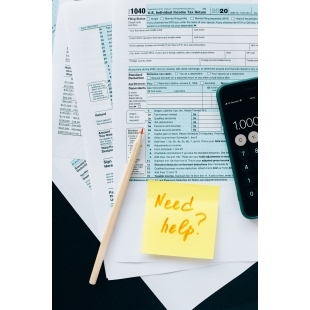
What business owners need to do when closing their doors for good
There are a few things business owners need to do before they close their business. Of course, they need to fulfill their federal tax responsibilities. It’s also important to notify the IRS of their plans.
Business owners must take these steps when closing a business:
File a final tax return and related forms. The type of return to file and related forms depends on the type of business.
Take care of employees. Business owners with one or more employees must pay any final wages or compensation, make final federal tax deposits and report employment taxes.
Pay taxes owed. Even if the business closes now, tax payments may be due next filing season.
Report payments to contract workers. Businesses that pay contractors at least $600 for services including parts and materials during the calendar year in which they go out of business, must report those payments.
Cancel EIN and close IRS business account. Business owners should notify the IRS so they can close the IRS business account.
Keep business records. How long a business needs to keep records depends on what's recorded in each document.
IRS.gov has information to help guide business owners through the process of shutting down.
Small businesses and self-employed taxpayers can find information including:
What forms to file
How to report revenue received in the final year of business
How to report expenses incurred before closure
Business owners can also get helpful information on declaring bankruptcy, selling their business and terminating retirement plans.
Resource:
https://www.irs.gov/newsroom/what-business-owners-need-to-do-when-closing-their-doors-for-good
What business owners need to do when closing their doors for goodmore -
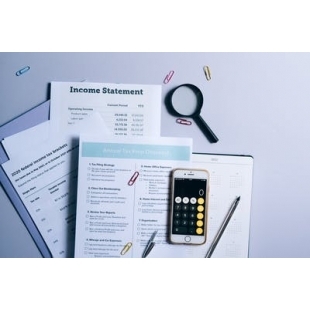
IRS announces interest rate increases for the fourth quarter of 2022; 6% rate applies to most taxpayers starting Oct. 1
IR-2022-150, August 15, 2022
WASHINGTON — The Internal Revenue Service today announced that interest rates will increase for the calendar quarter beginning October 1, 2022.
For individuals, the rate for overpayments and underpayments will be 6% per year, compounded daily, up from 5% for the quarter that began on July 1. Here is a complete list of the new rates:
6% for overpayments (5% for corporations). (payments made in excess of the amount owed)
3.5% for the portion of a corporate overpayment exceeding $10,000.
6% for underpayments. (taxes owed but not fully paid)
8% for large corporate underpayments.
Under the Internal Revenue Code, the rate of interest is determined on a quarterly basis. For taxpayers other than corporations, the overpayment and underpayment rate is the federal short-term rate plus 3 percentage points.
Generally, for a corporation, the underpayment rate is the federal short-term rate plus 3 percentage points, and the overpayment rate is the federal short-term rate plus 2 percentage points. The rate for large corporate underpayments is the federal short-term rate plus 5 percentage points. The rate on the portion of a corporate overpayment of tax exceeding $10,000 for a taxable period is the federal short-term rate plus one-half (0.5) of a percentage point.
The interest rates announced today are computed from the federal short-term rate determined during July 2022.
Revenue Ruling 2022-15PDF, announcing the rates of interest, will appear in Internal Revenue Bulletin 2022-35, dated August 29, 2022.
Source: https://www.irs.gov/newsroom/irs-announces-interest-rate-increases-for-the-fourth-quarter-of-2022-6-rate-applies-to-most-taxpayers-starting-oct-1
US TAX, U.S. TAXIRS announces interest rate increases for the fourth quarter of 2022; 6% rate applies to most taxpayers starting Oct. 1more






